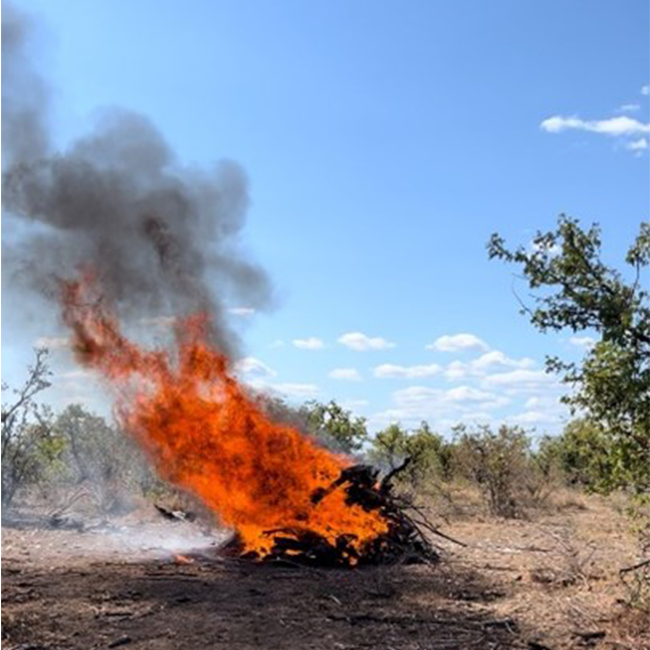My daunting first Vulture poisoning as a new EWT field officer
By Kyle Walker, field officer in the Birds of Prey Programme and Carnivore Conservation Programme

It’s my first week working for the Endangered Wildlife Trust in April 2023 and I’ve just moved to the Lowveld from the Cape. The temperature in the Mopani veld is beyond uncomfortable and much to my surprise, I’m missing the Cape winds.
Having just secured a field officer position with the EWT, I am aware that it is only a matter of time before a vulture poisoning event occurs. It will be my job to respond to these events in future, although, up to this point I have only ever seen photos and videos posted on social media. My days of being an arm-chair warrior are about to change.
Mid-way through my morning meeting I’m told that the rangers in Kruger National Park’s, Mooiplaas section (or Beautiful Farm in English), have discovered a poisoning scene with an unknown number of dead vultures. The information trickles in throughout the next hour as we race up north with our mobile veterinary trailer, the EWT’s Vulture Ambulance, in tow. It sounds as if only a couple birds are still alive, but we are prepared to treat as many survivors as possible. It’s a long drive and I have time to reflect upon what I’m about to see. Thoughts like – how am I going to hold the vulture? Will I get bitten? What happens if I come in to contact with the poison? Will I cope with seeing a lot of dead animals? Will I get there in time to save a few survivors? All these thoughts consume my mind, but I sit back and concentrate on the drive ahead. After all, what’s the use if I don’t arrive at the scene in one piece.
We drive through the Phalaborwa gate with a quick wave to the guards. This is not the first time they’ve seen this vehicle. John Davies, our Raptor Conservation and Research Project coordinator, as well as my predecessors, have been attending vulture poisonings in this area since 2014 and there are not many people better equipped to handle the situation ahead.
Unlike the slow-moving cars filled with eager-eyed tourists, ours darts past with little time spared to view the herds of Elephant and Buffalo. It’s a strange feeling knowing that I’m no longer on a tourist permit and that the lives of a few animals now hang in the balance of our arrival. Up the H14 road towards Mopani, hook right towards Letaba and a further 15 km along the dirt road to the scene.
We arrive at what looks to be a very peaceful dam. An Elephant bull is slowly wading through the water and a Marabou Stork is perched atop a Leadwood tree. Our vehicle pulls up to the ranger’s vehicle and we jump out to greet everyone and get the lowdown. The area adjacent to the dam is completely open and as I get my bearings I start seeing the aftermath of the poison.
Strewn around the area are small, feathered carcasses. A Tawny Eagle below the giant Green Thorn tree, three White-backed Vultures below another tree, a Lappet-faced Vulture facedown in the open.


But, first things first, there are two very weak White-backed Vultures lying in the shade in front of us. John sets about mixing an activated charcoal mixture while instructing me on how to hold the vultures safely. Holding birds is not new to me, but never have I held one this size. With the vulture cradled in my arm and its head firmly in my hand, we begin administering fluids. The fluids are used to flush the remaining poison from the bird’s system. It is not the final solution, but it does allow us time to transport them back to a veterinary facility where they will receive the necessary care and attention. With both birds safely stowed in travel boxes, we move on to the cleanup, intermittently checking in to keep the survivors hydrated.
The scene was worse than expected. A 500 metre radius around the poisoned Buffalo carcass was searched and the field rangers are now unloading carcasses by the wing-load. We line the birds up and group them by species. It’s a hammer blow to the senses. Everything smells rancid. Some carcasses are fresh, and others are a few days old. One by one we photograph each of the 80 dead birds before pilling them up to dispose of everything. Wood, diesel and carcasses make for one big bonfire, but its not the type I enjoy watching.
With the area cleaned up we head home with the two rescued vultures. I’m burnt, dehydrated and emotionally drained. The only thing keeping my spirits intact is the hope that these two vultures make a recovery and return to the African sky.
One month later and I’m standing in Moholoholo Rehabilitation Center with our two vultures looking fit and healthy. They have made a full recovery and it’s finally time to release them. We fit each bird with a GPS satellite tracking device which we will monitor to help locate future poisoning events in the Greater Kruger National Park region.
Scenes like these have become an all-too-common feature of conservation throughout Africa. Although there have been significant inroads made regarding the treatment of poisoned wildlife, the locating of poison sources, and the management of poisoning scenes, there is still significant work to do. One positive is that, should the severity of these poisonings be controlled, and their frequency reduced, we can still maintain viable populations of avian scavengers throughout these vast landscapes.

